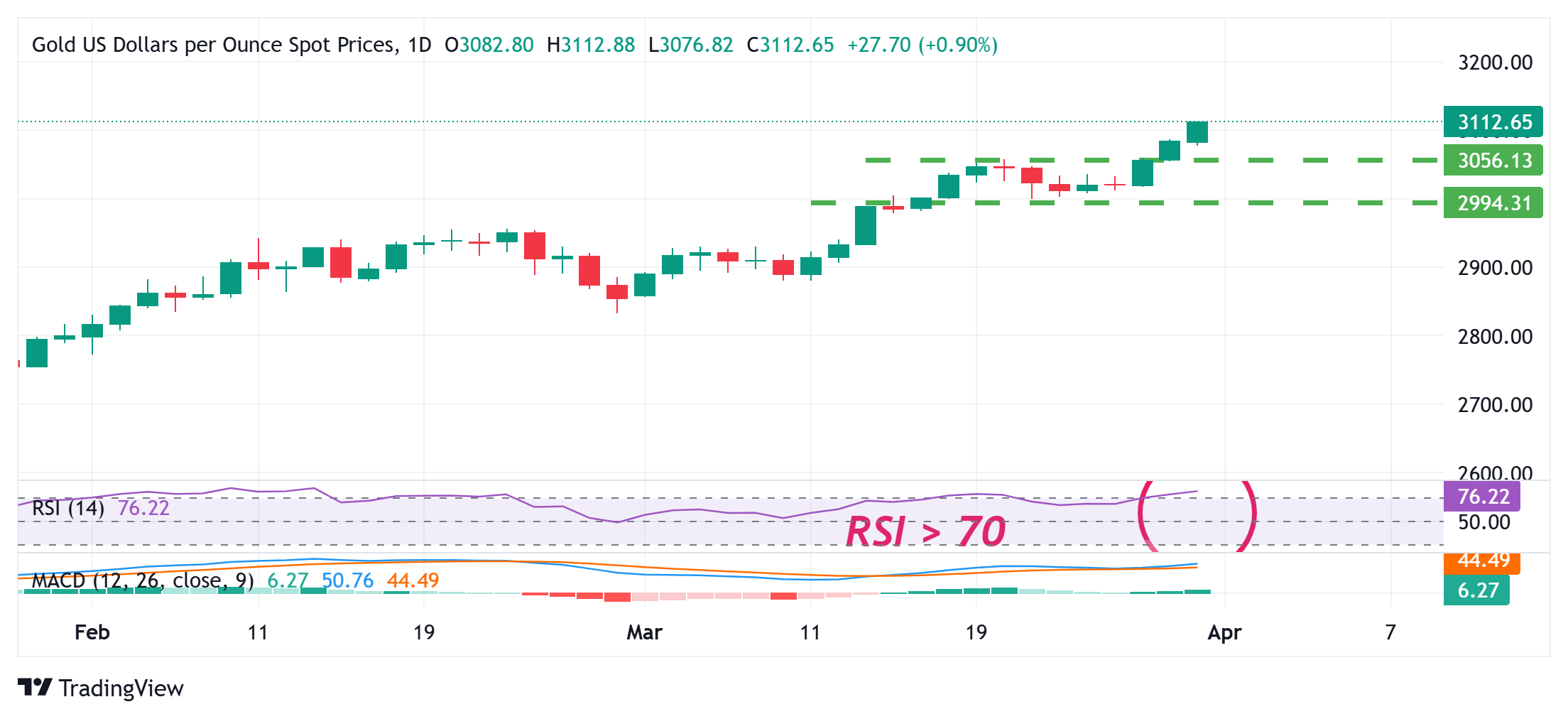- Gold price attracts safe-haven flows for the third straight day amid rising trade tensions.
- Fed rate cut bets weigh on the USD and also lend support to the non-yielding yellow metal.
- Overbought conditions on the daily chart now warrant some caution for bullish traders.
Gold price (XAU/USD) builds on its intraday ascent through the early European session on Monday and jumps to a fresh record high, around the $3,128 region in the last hour. Persistent worries about the potential economic fallout from US President Donald Trump’s aggressive trade tariffs continue to weigh on investors’ sentiment. Apart from this, geopolitical risks drive safe-haven flows toward the precious metal for the third successive day.
Furthermore, the prevalent US Dollar (USD) selling bias, amid the growing acceptance that the Federal Reserve (Fed) will start cutting interest rates again in June on the back of a tariff-drive US economic slowdown, further underpin the non-yielding Gold price. Adding to this, data released on Friday pointed to signs of rising inflation in the US and turns out to be another factor that benefits the precious metal’s hedge against rising prices.
Daily Digest Market Movers: Gold price continues to attract safe-haven flows amid trade woes
- US President Donald Trump rattled markets last week by imposing a 25% levies on all non-American cars and light trucks ahead of the so-called reciprocal tariffs set to take effect on April 2. Adding to this, the Wall Street Journal reported on Sunday that the Trump administration is considering higher trade tariffs against a broader range of countries, pushing the safe-haven Gold price to a fresh record high during the Asian session on Monday.
- Trump said on Sunday that he was very angry and pissed off at Russian President Vladimir Putin, and threatened massive tariffs on Russian oil and potential bombings in Iran. Trump also lashed out at Ukrainian President Volodymyr Zelenskiy and warned that he would face big problems if he backed out of the critical rare earth minerals deal. This further weighs on investors’ sentiment and contributes to the global flight to safety.
- Meanwhile, US data released on Friday showed that the Personal Consumption Expenditures (PCE) Price Index rose 0.3% in February and 2.5% from a year ago – in line with market expectations. However, the core gauge, which excludes volatile food and energy prices, showed a 0.4% increase for the month. This marked the biggest monthly gain since January 2024 and lifted the 12-month inflation rate to 2.8% during the reported month.
- Additional details revealed that Consumer Spending accelerated 0.4% following a downwardly revised 0.3% fall in January, while Personal Income posted a 0.8% rise during the reported month. Separately, a survey from the University of Michigan showed that consumers’ 12-month inflation expectations soared to the highest level in nearly 2-1/2 years in March, which further benefits the precious metal’s hedge against rising prices.
- This comes on top of persistent worries about slowing US economic growth and fuels stagflation fears, dragging the US Dollar lower for the third straight day and further offering support to the XAU/USD pair. The commodity reacts little to China’s official Purchasing Managers’ Index (PMI), which showed that the Manufacturing PMI edged higher to 50.5 while the Non-Manufacturing PMI jumped to 50.8 in March.
- Traders now look forward to this week’s important US macro releases scheduled at the beginning of a new month, including the closely-watched Nonfarm Payrolls (NFP) report on Friday. In the meantime, overbought conditions might hold back bulls from placing fresh bets and cap the yellow metal. The fundamental backdrop, however, suggests that the path of least resistance for the commodity remains to the upside.
Gold price bulls could pause for a breather amid overbought RSI on the daily chart

From a technical perspective, Friday’s sustained breakout above the previous all-time peak, around the $3,057-3,058 region, was seen as a fresh trigger for bullish traders. That said, the Relative Strength Index (RSI) on the daily chart remains above the 70 mark for the third straight day and points to overstretched conditions. Hence, it will be prudent to wait for some near-term consolidation or a modest pullback before positioning for an extension of the recent well-established uptrend witnessed over the past three months or so.
Meanwhile, any corrective pullback below the Asian session low, around the $3,076 area, now seems to find decent support near the aforementioned resistance breakpoint. This is followed by the $3,036-3,035 support zone, below which the Gold price could accelerate the slide back towards retesting the $3,000 psychological mark. The latter should act as a key pivotal point, which if broken decisively might shift the near-term bias in favor of bearish traders and pave the way for deeper losses.
Tariffs FAQs
Tariffs are customs duties levied on certain merchandise imports or a category of products. Tariffs are designed to help local producers and manufacturers be more competitive in the market by providing a price advantage over similar goods that can be imported. Tariffs are widely used as tools of protectionism, along with trade barriers and import quotas.
Although tariffs and taxes both generate government revenue to fund public goods and services, they have several distinctions. Tariffs are prepaid at the port of entry, while taxes are paid at the time of purchase. Taxes are imposed on individual taxpayers and businesses, while tariffs are paid by importers.
There are two schools of thought among economists regarding the usage of tariffs. While some argue that tariffs are necessary to protect domestic industries and address trade imbalances, others see them as a harmful tool that could potentially drive prices higher over the long term and lead to a damaging trade war by encouraging tit-for-tat tariffs.
During the run-up to the presidential election in November 2024, Donald Trump made it clear that he intends to use tariffs to support the US economy and American producers. In 2024, Mexico, China and Canada accounted for 42% of total US imports. In this period, Mexico stood out as the top exporter with $466.6 billion, according to the US Census Bureau. Hence, Trump wants to focus on these three nations when imposing tariffs. He also plans to use the revenue generated through tariffs to lower personal income taxes.
BRANDED CONTENT
Not all brokers provide the same benefits for Gold trading, making it essential to compare key features. Knowing each broker’s strengths will help you find the ideal fit for your trading strategy. Explore our detailed guide on the best Gold brokers.

